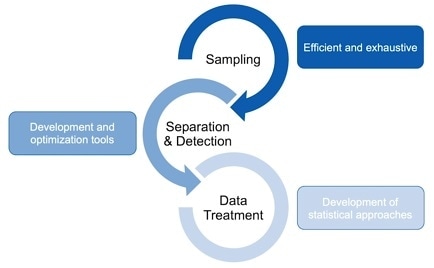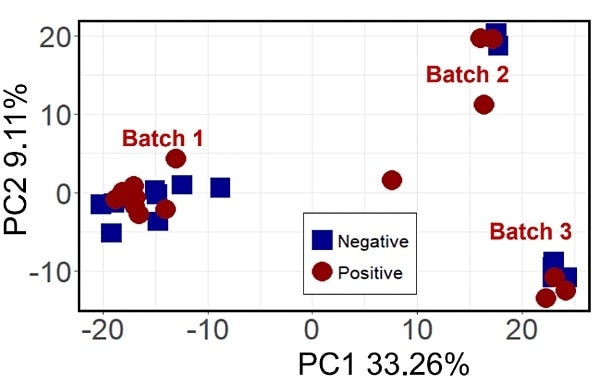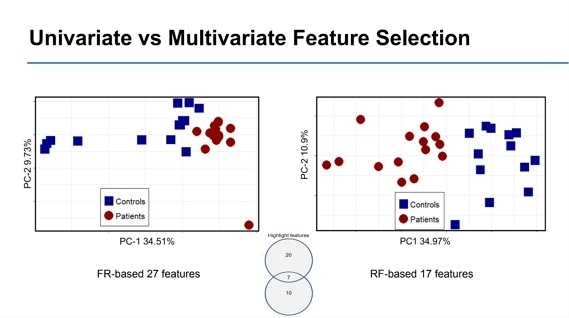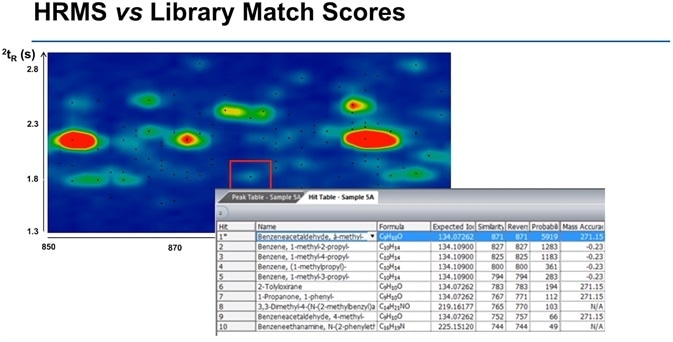At LECO’s ASMS breakfast seminars, Jean-François (Jef) Focant, Head of the Department of Chemistry and Director of the Organic and Biological Analytical Chemistry group at the University of Liège, Belgium, discussed using the Pegasus® BT 4D and Pegasus® GC-HRT 4D for GCxGC-TOFMS on the breath of asthma patients to enhance treatments for asthma.*

Image Credit: LECO Corporation
Before plunging into the blood and sputum, Jef initially informed the audience of the importance of optimizing your data.
For each clinical project that Jef's group evaluates, three "pillars" typically make up the project.
First, samples must be acquired. Then, the samples must be passed through a mass spectrometer for separation and detection. Finally, the resulting data must be treated in the appropriate manner to produce useful and intelligible results.

Image Credit: LECO Corporation
While Data Treatment was previously the smallest of the pillars, developments in LECO's technology mean that a vast amount of data is created. Thus, it has become crucial to break this data up and make it more manageable.
"Because when we go to the hospital and we speak with our colleagues, they don't really care if I start to tell them 'Oh, the modulation period was 4 seconds, the acquisition speed was 250 hertz...' they say 'Yes, yes,' because they are polite, but they just don't give a sh** to that. They just want to know: is it a positive sample or a negative sample?"
In relation to patient care, reducing false negatives or false positives is vital when providing the appropriate treatment. Each of the three pillars plays a key role in this process.
All results start with obtaining a sample. There are various ways of obtaining a sample from an asthmatic patient, but several are considered to be "invasive" procedures, such as collecting blood or sputum, bronchial brushings, bronchoalveolar lavage and bronchial wall biopsies.
On the other hand, collecting breath condensates in a Tedlar® bag is a fairly rapid and painless technique to acquire a patient sample. What’s more, it is relatively simple to explain to a patient that they just need to blow into the bag provided.
Once the sample has been acquired and transported to the lab, LECO's Pegasus® BT 4D can separate and identify the hundreds of thousands of elements contained within the sample.
Yet, it is during this phase where many people go wrong.
[Y]ou have to be sure that you can use good data. It's, again, a drawback of GCxGC and TOFMS because the instruments are so good that you can end up having poor modulation efficiency, bad peak shape, and still the system will give you some information. But it will be more difficult for the system to give you good information. So having good peak shape, good peak intensity, good separation is always very important."
Jean-François (Jef) Focant, Head of the Department of Chemistry and Director of the Organic and Biological Analytical Chemistry group, The University of Liège, Belgium

Image Credit: LECO Corporation
Once the data has been processed, applications of statistical treatments can commence. Prior to testing asthma patients, Jef's group initially ran some experiments using a test group of lung cancer patients and another control group.
Firstly, they wanted to determine if breath condensates were feasible when determining a patient’s health. The initial data treatments did exhibit some separation between the groups, but they produced three distinct groups rather than just two.
They were able to establish that the detection of environmental VOCs had also occurred amid the cancerous VOCs, and the three groups identified the three different times of the year in which samples were taken. While indeed a captivating statistic, this was not the desired outcome as intended.

Image Credit: LECO Corporation

Image Credit: LECO Corporation
Utilizing different classification methods, Jef was able to condense the 1350 features identified into two sets: 27 with Fisher Ratio and 17 with Random Forest, of which 7 overlapped.
From there, Jef was able to divide the samples into two clear-cut groups, those positive for lung cancer and those negative for lung cancer.
Using the high-resolution Pegasus® GC-HRT 4D on the samples, Jef could further identify the specific compounds he was utilizing as markers.

Image Credit: LECO Corporation
As illustrated above, the marked peak first appears to be Benzeneacetaldehyde, with a library match score of 871.
However, the high-resolution mass spec enabled Jef to observe that the mass accuracy was a measly 271.15 ppm, whereas the next result, likely Benzene, with a similarity of 827, had an improved mass accuracy of -0.23 ppm.
By applying the two instruments in tandem, Jef was able to acquire significantly better chemical information from his data.
Therefore, Jef was able to use this experience and effectively use it in an asthma breathprint study.
Over the past decade, there has been a 200% increase in asthma cases, affecting 14% of children under the age of 18 and over 334 million people globally.
It is a problem that is on the increase, and yet 20% of asthma patients are prescribed the wrong medicine.
There are two primary phenotypes for asthma: neutrophilic and eosinophilic. Neutrophilic asthma is typically caused by pollutants and infections and as such can be treated with antibiotics, while allergens are responsible for triggering eosinophilic asthma which is usually treated with corticosteroids.
Consequently, antibiotics are ineffective for the treatment of eosinophilic asthma and corticosteroids do nothing for neutrophilic asthma.
As previously stated, a vast number of the methods used to diagnose asthma are usually invasive, offering a 67-72% rate of accuracy.
Jef's group rose to the challenge of taking breath condensates from asthmatic patients to see if GCxGC-TOFMS could generate a more feasible diagnosis.
To find out more about Jef’s group results, watch the complete breakfast seminar recording from this year's ASMS here.
Notes:
*This statement has not been evaluated by the Food and Drug Administration. This product is not intended to diagnose, treat, cure, or prevent any disease.
About LECO Corporation.jpg)
In 1936, the Laboratory Equipment Company introduced the first rapid carbon determinator to the American iron and steel industry. Today, 75 years later, LECO is recognized globally as a leader in innovative analytical instrumentation, mass spectrometers, metallography and optical equipment, and consumables.
LECO's broad selection of innovative instrumentation incorporates trendsetting automation, easy-to-use software, and the latest technologies into ergonomic designs. This results in instruments that are fast, accurate, and user-friendly—allowing you to increase productivity by achieving a level of throughput that was once unobtainable for many lab managers.
Our four diverse product lines offer you analytical solutions in five different market areas, meeting objectives for a wide variety of applications and scientific techniques. These market areas are described below.
Inorganic Analysis
Determinators for carbon, sulfur, hydrogen, nitrogen, and oxygen used for metal and inorganic analyses; glow discharge spectrometers for bulk and/or quantitative depth profile analysis.
Organic Analysis
Determinators for carbon, sulfur, hydrogen, nitrogen, and oxygen; analyzers for fat, protein, ash/moisture, mercury, and calorific value.
Microstructural Analysis
Metallographic sample preparation equipment; macro and microindentation hardness testers; microscopes; image analysis and management systems; optical accessories.
Separation Science (Mass Spectrometry)
Fast GC-TOFMS and LC-TOFMS systems with ChromaTOF® software dedicated to a wide variety of organic applications; GCxGC-TOFMS and GCxGC FID/ECD systems offer increased separation power.
Ceramics
Crucibles, ladles, stopper rods, nozzles, kiln furniture, and pressed refractory shapes for the foundry and investment casting industry.
Sponsored Content Policy: News-Medical.net publishes articles and related content that may be derived from sources where we have existing commercial relationships, provided such content adds value to the core editorial ethos of News-Medical.Net which is to educate and inform site visitors interested in medical research, science, medical devices and treatments.